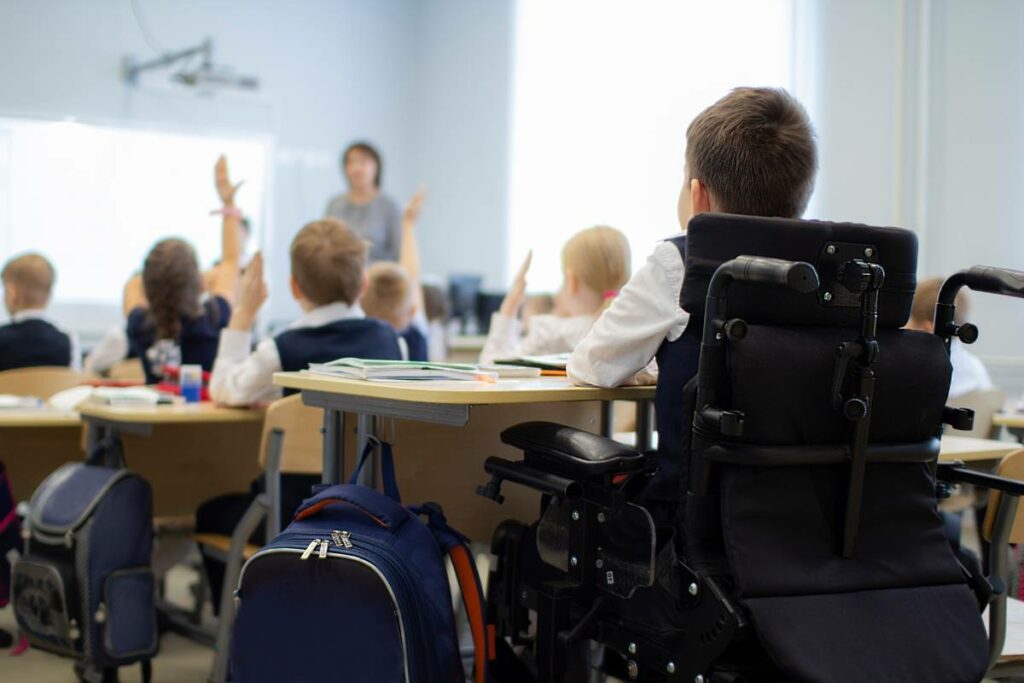When working with students with disabilities (SWDs), including physical, learning, neurodivergent, and mental health disabilities, there are many variables to consider. There are various laws and eligibility processes governing education are divided into two camps, SWDs who: a) have not yet graduated from high school, and b) high school graduates.
Chronologically, early intervention (EI) services can begin as early as age 3, and therefore it is often appropriate to render services in their homes due to developmental needs. The K-12 years are the traditional school years, although some SWDs may be enrolled in school through age 21. Graduates will be addressed infra within “higher education” or “college” sections, as adults. Instructional goals can be met in two ways, modification (PK-12) and accommodation (Adult). Generally, modification speaks to changing “what” is to be learned, while accommodation addresses “how” the learning occurs.
The PK-12 years are characterized by a school system’s educational and financial responsibility, parent/guardian advocacy, and focus upon a Free and Appropriate Public Education (FAPE). Individualized Education Programs (IEPs) and Individual Accommodation Plans (IAPs) are drafted to delineate instruction and related services to be provided, under the watchful eye of the Individuals with Disabilities Act (IDEA) and Section 504 of the Rehabilitation Act (part D).

However, the paradigm shifts as students with disabilities enter the college years. The Americans with Disabilities Act (ADA) and Section 504 of the Rehabilitation Act (part E) are now in play. College is more about equal access, where the student is now required to self- identify as a student seeking an accommodation, to provide documentation of such, and to do so at their own expense. Moreover, the student now enters the age of self-advocacy, unless seeking to retain a parent or guardian in that capacity, in concert with FERPA.
Regardless of the developmental level, it is critical to remember that each student is unique and will have different needs when learning and participating in the educational process. Focusing on the individual and providing them with the support they need can make a big difference in their academic success, and yours! Here are some tips for effectively working with differently abled students.
Creating Inclusive Environments
An inclusive educational system is foundational for the success of any educational efforts; a system composed of like-minded educational leaders, committed to the success of ALL students. It is important to collaborate with the numerous system assets such as the counseling center, academic support and tutoring, technology, student support groups, student conduct officers, housing (if applicable), teachers, administrators, and more.
Once established, a positive culture empowers teachers to create an inclusive environment in the classroom, including a welcoming, safe, engaging, and respectful space for ALL students, regardless of ability or any other factor. A culture of inclusion can be achieved by having class (school) discussions about acceptance and respect, as developmentally appropriate. Additionally, instructional activities can be infused with different cultures, beliefs, values, and experiences. These activities must occur within an intentionally developed atmosphere of trust and respectful exchange of ideas.
Providing Accessible Resources
Again, there exists a bifurcation of instructional and related services for SWDs, based upon developmental level. At the PK-12 level, there are specialized teachers of special education, and a host of related service providers such as counselors, speech therapists, occupational therapists, teachers of the deaf and more. Instruction and examinations can be modified to address specific student need. Developmentally appropriate modifications and testing accommodations may be performed by a teacher or other qualified staff.
When working with students with disabilities, it is essential to provide them with the resources they need to access the same material as other students without any physical or psychological barriers that may prevent them from doing so. Testing accommodations at this level do not require modifications but are most commonly achieved through testing accommodations like extended time or alternate location.
With the onset of such life changing assistive technologies, eligible students can avail themselves of numerous options like speech to text technology, e-books, recorders, and so much more. FM trainers, augmentative devices utilized to help hearing impaired students hear the teacher via an amplifier/receiver model, are commonly used for various disabilities. In fact, this technology has been successfully implemented for hearing impairments, ADHD, sensory processing disorders, and more. Preferential seating is one strategy which maximizes proximity to the teacher, dissuading unwanted distractions. It is interesting to note however, that many SWDs prefer to opt out of online learning, citing a benefit to in person learning.
The term “barrier” is often used to describe any educational hindrance for the SWD but can also be quite literally interpreted. New access issues arise at this level, as college students, including those with disabilities, often live in campus housing. Therefore, accommodations may include accessible living quarters, ramps, accessible or locking bathrooms, and more. Additionally, these dorms may now have “furry” occupants. The rise in mental health disabilities has prompted new accommodations, including access to therapy animals on college campuses. College campuses have also recognized the imperative of students to seek mental health assistance in a timely fashion, and systems are looking at a more flexible policy regarding assignment deadlines.
Developing Individual Learning Plans
The Individual Learning Plan (ILP) is a yet developing trend in (PK-12) education, focusing upon academic, vocational, and personal goal planning. It is not to be confused with an IEP. As a transition coordinator in NYS, I developed instruments to measure academic, vocational, and personal goals of SWDs. The ILP has its merits, including data management, need identification, self-awareness, setting short/long term goals, resource sharing, and data monitoring for efficacy. However, its purporters have met with the same bureaucratic opposition as other movements, namely the inability to operationally define such a document and make it universal.
In NYS, the IEP and IAP delineate goals for instruction and related services, and measure progress; all typically reviewed through the appropriate forum of a Committee on Special Education (CSE) or Section 504 meeting. For regular education students, most instructional goals are typically addressed via a Multi-Tiered System of Supports (MTSS) or Response to Intervention (RTI). The ILP notwithstanding, academic, vocational, and personal goals are indeed addressed via periodic meetings with strategic educational personnel. Behavioral issues are addressed by a behavior intervention plan (BIP), the result of a Functional Behavior Assessment (FBA).
At the higher education level, a SWD has access to a comprehensive and collaborative support group including a disability resource point person, professors, academic advisors, counselors and more by which to access accommodations, set goals, receive advisement, access needed services, and more.
Encouraging Positive Behavioral Strategies
In a somewhat recent trend, Social Emotional Learning (SEL) is utilized in teaching children and adults the skills of self-awareness, and then offering a common language by which to describe such. SEL builds upon self-awareness, equipping students to regulate their behavior by helping them develop self-control and resilience skills. Encouraging positive behavioral strategies means teaching students to manage their behavior using techniques such as self-monitoring, problem-solving, and negotiation skills instead of relying solely on punitive detentions or suspensions. The goal is to eventually create emotionally intelligent adults who apply these skills outside of the school setting, and better navigate life’s challenges independently and confidently. Creating a sense of empathy also equips a student to better navigate the waters of restorative justice, allowing them to see the adverse impact(s) of their behavior. Two prominent resources for such are Yale’s Center for Emotional Intelligence (RULER) and the Collaborative for Academic, Social, and Emotional Learning (CASEL).
Establishing A Connection with the Student
When working with ANY student, including a student with a disability, it is essential to establish a [proper] connection with them. An oft quoted expression of an educator’s truism is, “a student does not care what you know, until they know that you care.” My time proven professional experience and published research both concur that the establishment of appropriate relationships in educational systems is critical for our students and staff alike.
As educators, we must begin with an empathetic stance, listening to the need(s) of our students while providing a safe and respectful educational culture. This provides valuable information which may be leveraged by infusing the student’s preferences into instruction (differentiation), thereby creating instant engagement. Again, self-disclosure, especially of such identity laden topics, must be protected in a safe environment.
Successful disclosure perpetuates engagement, and engagement is positively linked to learning. Additionally, having regular conversations with the student allows the teacher to understand the support the student will need to succeed academically, and nurtures diversity, equity, and inclusion (DEI) goals within the class.
Conversely, at the college level, the onus of responsibility is upon the student to initiate conversation with the accommodations staff, teacher/professor, or other partners. Once established, any of those partners are free to engage and support the student.
Communicating Effectively with Parents
In the PK-12 arena, parents often play an active role in helping their children succeed in school by providing emotional support and advocating on their children’s behalf when necessary. Therefore, teachers must maintain open communication to inform parents of academic progress, or other concerns they may have regarding their children’s [special] education. This may seem an easy venture, however often cited hindrances may include disability, language, literacy, culture, race, poverty, access to technology, transportation and more. Through addressing these potential challenges, regular communications via meetings or conferences can help build a strong relationship between the teacher and parent, when occurring within an environment of mutual respect.
Again, in higher education, parents are included in such communication only at the expressed wishes of the student, per FERPA.
When To Seek Further Support
In a PK-12 setting, teachers usually provide support and assistance to students with disabilities, and often function as a case manager. Education is fluid, and students may require a change to some component of their program due to multiple factors. The IEP or IAP can be amended, but typically the need of a student arises from a scheduled review, or from an emergency meeting due to some pressing issue. Relevant partners present data, evaluate it in committee, and make program or service decisions. In this model, the school is responsible to initiate services, although the parent/guardian continues to advocate for the student.
In higher education, the student, having initially self-disclosed to disability services staff, and having been found eligible for services, is typically monitored via staff utilizing a client service management (CRM) system. These systems are quite sophisticated, and can comprehensively and effectively track a student’s progress, targeted needs, and access to supports. This might include enumerating the specific accommodation needs, tracking attendance, assignments and grades, and efficiently “flagging” a concerning behavior, which triggers a response or referral to a support service. The parent is only involved if specifically requested by the student, as per FERPA.
Teachers in either developmental setting should be aware of their system’s protocol for an emergency. In the event of any urgent student matter, including a mental health crisis, knowing your point person is critical. A PK-12 school often employs a crisis team for such purposes.
In one higher education best practice, staff address such crises via a CARE (Campus Assessment, Response and Evaluation) Team, according to SUNY. The team is comprised of partners such as campus responders, which may include the Dean of Students, Public Safety, Counseling Services, a teaching-Faculty member and Director of Housing.
Teachers should also be aware of any local or national support services available to students with disabilities in their area.
By implementing these strategies, teachers can ensure that students with disabilities receive the help and support they need to succeed academically and develop into emotionally intelligent adults who can independently navigate life’s challenges.
Final Thoughts
Working with students, including those with disabilities, requires empathy, patience, understanding, collaboration, and creativity on behalf of teachers and the entire educational community. Still, when done correctly, it can have a hugely positive impact on both their academic performance and emotional well-being.
Sadly, I must warn you that in some educational systems, unsuspecting educators are asked or directed to intentionally ignore the law regarding the students with disabilities in their care. You may be offered promotion or even be threatened. It behooves you to prepare for such preemptively, as your response may not be the one you think.
However, ethical teachers and leaders possess an uncanny resilience to such coercion, even when unpopular. The law in fact protects such courage, at least according to the statute. Please be assured that you are creating and nurturing an inclusive environment where ALL students can learn, regardless of any physical or mental disability… allowing everyone an equal opportunity for success! Do not be dissuaded…by anyone.



